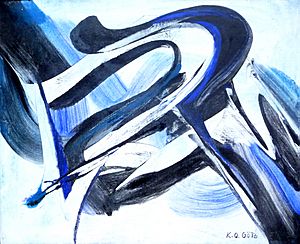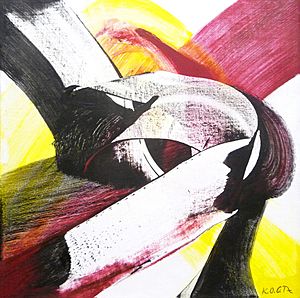Karl Otto Götz facts for kids
Quick facts for kids
Karl Otto Götz
|
|
|---|---|
| Born | 22 February 1914 |
| Died | 19 August 2017 (aged 103) Niederbreitbach, Germany
|
| Other names | K.O. Götz |
| Occupation | Artist, filmmaker, draughtsman/printmaker, writer, and art professor |
Karl Otto Götz (born February 22, 1914 – died August 19, 2017), often called K.O. Götz, was a famous German artist. He was also a filmmaker, a talented drawer, a printmaker, a writer, and an art professor. Götz was known for his energetic and complex abstract art. His powerful, dream-like artworks gained him international fame. He showed his art in big exhibitions like documenta II in 1959.
Götz never stuck to just one art style. He also explored making abstract shapes using television technology. He is a very important artist in the German Art Informel movement. His art and his teaching influenced many future artists, including Sigmar Polke, Nam June Paik, and Gerhard Richter. He lived in Wolfenacker from 1975 until he passed away.
Contents
Personal Life
Karl Otto Götz was born in Aachen, Germany. He started painting in secondary school in 1924. By 1930, he began creating abstract paintings. He studied at the School of Applied Arts from 1932 to 1933. His early artworks were inspired by modern art styles like surrealism and expressionism.
Artists like Max Ernst, Juan Gris, Wassily Kandinsky, and Paul Klee especially influenced Götz. When the Nazi Party took control of Germany, painting became difficult for him. He was not allowed to paint or show his art because abstract and surrealist art was not approved. However, he managed to earn money by painting and selling landscape pictures.
Götz served in the German Air Force (called the Luftwaffe) from 1936 to 1938. During World War II, he worked as a signal officer in German-occupied Norway. Even then, Götz found ways to experiment with different art materials. He used spray paint, made photograms (pictures created by placing objects on special paper and exposing it to light, without a camera), and created abstract films.
After the war, he moved to Dresden, Germany. He focused on abstract painting, mixing geometric and natural shapes. Sadly, his early paintings were destroyed during the Bombing of Dresden in 1945. Götz returned from Norway after the war and married artist Anneliese Brauckmeyer. Their marriage ended in 1965, and Götz later married German artist Rissa.
Career
Experimenting with Television Art
Television art is art made for or with broadcast television. Because TV uses electronic signals and has a lower picture quality, this type of art was often abstract. Artists who worked with non-realistic art in other ways often explored television art.
During the war, Götz worked with ground-based radars. He started to change these radars electronically to create moving abstract shapes. His goal was to make "electron paintings" that looked like animated TV pictures. Götz's ideas influenced artists like Nam June Paik, who is known as the founder of video art. It is believed that these experiments led Götz to focus only on abstract art.
Early Art Journey
After the war, Götz experimented a lot with different art techniques. He made prints and drawings, including some using an airpump. He created woodcuts and watercolors with fantastic plants and creatures. He also made a series of monotype prints (unique prints from a single plate) of bird-human figures. In the late 1940s, he continued making abstract-figurative monotypes and surreal photo works. However, his paintings became mostly abstract.
In 1946, he began experimenting with solarization. This is a process similar to photograms, where light and dark areas in a photo are reversed or partially reversed. Götz had his first solo art show in 1947. Two years later, in 1949, Götz completely stopped making art that showed real objects. That same year, he was the first German artist to join the European avant-garde group called COBRA.
COBRA was an art movement in Europe active from 1948 to 1951. This group, though together for a short time, created many publications and exhibitions. Their work helped lead to the rise of Art Informel after 1950. Art Informel became a "universal language" for European artists developing abstract expressionism.
In 1952, Götz helped start the Frankfurt QUADRIGA group with Otto Gries, Heinz Kreutz, and Bernard Schultze. The artists in QUADRIGA were pioneers of Art Informel in Germany. They painted in a style called Tachisme, influenced by artists like Wols and Automatism (automatic drawing). QUADRIGA played an important role in bringing Art Informel to Germany.
From then on, Götz became a leading figure in German Art Informel. His work was shown in major exhibitions like the Venice Biennale of 1958 and the Documenta II exhibition in Kassel in 1959. That year, he became an art professor at the Kunstakademie Düsseldorf.
As Götz moved away from clear shapes, his painting style became more energetic. He developed a special technique he used for many years. First, he would make many sketches and gouaches (paintings using opaque watercolors). Once ready, he would quickly apply dark paint onto a light background with a paintbrush. Then, he would partially remove the paint using a special spatula called a "rake." Finally, he would soften the contrast between light and dark areas with a dry paintbrush while the paint was still wet.
Later Art Journey
Starting in 1971, Götz began conducting experiments at the Düsseldorf Academy. These studies focused on how people see things and how it relates to their personality. His research is recognized by psychologists around the world.
From 1995 to 2001, Götz started creating ceramic pieces. Some of these, like his plates and vases, were decorated with his unique, bold brushstrokes. In other works, these brushstrokes became three-dimensional shapes. Several of his low relief sculptures show the same flowing movement found in his paintings.
Götz's later work (around 2010) included deeply colored abstract collages. He also made hand-painted pieces based on computer-generated random pixelation patterns. In 1997, the KO Götz and Rissa Foundation was created. Its goal is to promote art and culture by making the works of KO Götz and Rissa more available to the public. This is done through showing their art in museums and other art places. Götz turned 100 years old in February 2014. He passed away on August 19, 2017, at the age of 103.
Influence
Besides his own art, Götz was also a very successful art teacher. From 1959 to 1979, while he was a professor at the Kunstakademie Düsseldorf, many students who later became famous artists studied with him. For example, in 1959, his first students included Gotthard Graubner, HA Schult, and Kuno Gonschior.
From 1961 onwards, Gerhard Richter and Sigmar Polke also studied under Götz. His later wife, Rissa, and Franz Erhard Walther were also among his students.
See also
 In Spanish: Karl Otto Götz para niños
In Spanish: Karl Otto Götz para niños
- List of German painters




